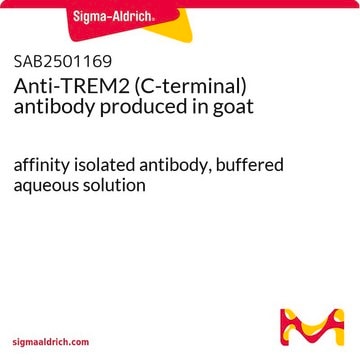推薦產品
生物源
rabbit
品質等級
共軛
unconjugated
抗體表格
affinity isolated antibody
抗體產品種類
primary antibodies
無性繁殖
polyclonal
產品線
Prestige Antibodies® Powered by Atlas Antibodies
形狀
buffered aqueous glycerol solution
物種活性
mouse, human, rat
技術
immunoblotting: 0.04-0.4 μg/mL
immunofluorescence: 0.25-2 μg/mL
immunohistochemistry: 1:50-1:200
免疫原序列
PSGIFDVNSRKSSTGSISNVLFSTQDPVEDAVFGEATNLKKNGDRGEKRQKHFPERSCSFSSESRAGMLLKKSSLDSNSSEMAIMMGADAKILTAALTCPKTSLLHIARTHSFENVSCHLPDSRTCMSESTW
UniProt登錄號
運輸包裝
wet ice
儲存溫度
−20°C
目標翻譯後修改
unmodified
基因資訊
human ... DENND4C(55667)
一般說明
DENND4C (DENN/MADD domain containing 4C) is a member of the DENND4 subfamily of DENND proteins. It resides in the cytosol, and contains the characteristic DENN domain, which acts as the GEF (guanine nucleotide exchange factor) domain. It is a human homolog of calmodulin-binding protein related to a Rab3 GDP/GTP exchange protein (Crag).
免疫原
DENN domain-containing protein 4C recombinant protein epitope signature tag (PrEST)
應用
All Prestige Antibodies Powered by Atlas Antibodies are developed and validated by the Human Protein Atlas (HPA) project and as a result, are supported by the most extensive characterization in the industry.
The Human Protein Atlas project can be subdivided into three efforts: Human Tissue Atlas, Cancer Atlas, and Human Cell Atlas. The antibodies that have been generated in support of the Tissue and Cancer Atlas projects have been tested by immunohistochemistry against hundreds of normal and disease tissues and through the recent efforts of the Human Cell Atlas project, many have been characterized by immunofluorescence to map the human proteome not only at the tissue level but now at the subcellular level. These images and the collection of this vast data set can be viewed on the Human Protein Atlas (HPA) site by clicking on the Image Gallery link. We also provide Prestige Antibodies® protocols and other useful information.
The Human Protein Atlas project can be subdivided into three efforts: Human Tissue Atlas, Cancer Atlas, and Human Cell Atlas. The antibodies that have been generated in support of the Tissue and Cancer Atlas projects have been tested by immunohistochemistry against hundreds of normal and disease tissues and through the recent efforts of the Human Cell Atlas project, many have been characterized by immunofluorescence to map the human proteome not only at the tissue level but now at the subcellular level. These images and the collection of this vast data set can be viewed on the Human Protein Atlas (HPA) site by clicking on the Image Gallery link. We also provide Prestige Antibodies® protocols and other useful information.
生化/生理作用
DENND4C (DENN/MADD domain containing 4C) acts as a guanine nucleotide exchange factor (GEF) for Rab10, and converts Rab10-GDP to Rab10-GTP. This is involved in the translocation of GLUT4. Studies show that a variant in the non-coding part of this gene is mildly linked with type 2 diabetes.
特點和優勢
Prestige Antibodies® are highly characterized and extensively validated antibodies with the added benefit of all available characterization data for each target being accessible via the Human Protein Atlas portal linked just below the product name at the top of this page. The uniqueness and low cross-reactivity of the Prestige Antibodies® to other proteins are due to a thorough selection of antigen regions, affinity purification, and stringent selection. Prestige antigen controls are available for every corresponding Prestige Antibody and can be found in the linkage section.
Every Prestige Antibody is tested in the following ways:
Every Prestige Antibody is tested in the following ways:
- IHC tissue array of 44 normal human tissues and 20 of the most common cancer type tissues.
- Protein array of 364 human recombinant protein fragments.
聯結
Corresponding Antigen APREST73490
外觀
Solution in phosphate-buffered saline, pH 7.2, containing 40% glycerol and 0.02% sodium azide
法律資訊
Prestige Antibodies is a registered trademark of Merck KGaA, Darmstadt, Germany
免責聲明
Unless otherwise stated in our catalog or other company documentation accompanying the product(s), our products are intended for research use only and are not to be used for any other purpose, which includes but is not limited to, unauthorized commercial uses, in vitro diagnostic uses, ex vivo or in vivo therapeutic uses or any type of consumption or application to humans or animals.
未找到適合的產品?
試用我們的產品選擇工具.
儲存類別代碼
10 - Combustible liquids
水污染物質分類(WGK)
WGK 1
閃點(°F)
Not applicable
閃點(°C)
Not applicable
個人防護裝備
Eyeshields, Gloves, multi-purpose combination respirator cartridge (US)
Bo Xiong et al.
PLoS biology, 10(12), e1001438-e1001438 (2012-12-12)
Rhodopsins (Rhs) are light sensors, and Rh1 is the major Rh in the Drosophila photoreceptor rhabdomere membrane. Upon photoactivation, a fraction of Rh1 is internalized and degraded, but it remains unclear how the rhabdomeric Rh1 pool is replenished and what
Hiroyuki Sano et al.
The Journal of biological chemistry, 286(19), 16541-16545 (2011-04-02)
Insulin-stimulated translocation of the glucose transporter GLUT4 to the cell surface in fat and muscle cells is the basis for insulin-stimulated glucose transport. Studies in adipocytes strongly support the following molecular mechanism for this process. Insulin-elicited phosphorylation of the GTPase-activating
Kirsty J McMillan et al.
The Journal of cell biology, 214(4), 389-399 (2016-08-17)
The retromer complex acts as a scaffold for endosomal protein complexes that sort integral membrane proteins to various cellular destinations. The retromer complex is a heterotrimer of VPS29, VPS35, and VPS26. Two of these paralogues, VPS26A and VPS26B, are expressed
Shin-ichiro Yoshimura et al.
The Journal of cell biology, 191(2), 367-381 (2010-10-13)
A key requirement for Rab function in membrane trafficking is site-specific activation by GDP-GTP exchange factors (GEFs), but the majority of the 63 human Rabs have no known GEF. We have performed a systematic characterization of the 17 human DENN
Frances C Tilley et al.
Journal of cell science, 131(11) (2018-05-05)
Autosomal dominant polycystic kidney disease (ADPKD) is the most common monogenic human disease, with around 12.5 million people affected worldwide. ADPKD results from mutations in either PKD1 or PKD2, which encode the atypical G-protein coupled receptor polycystin-1 (PC1) and the
我們的科學家團隊在所有研究領域都有豐富的經驗,包括生命科學、材料科學、化學合成、色譜、分析等.
聯絡技術服務








